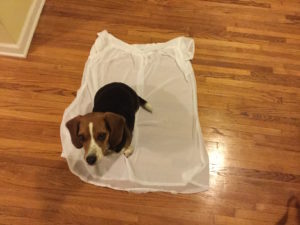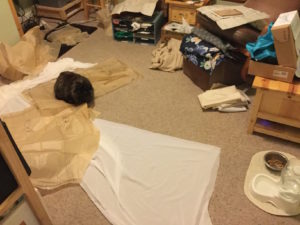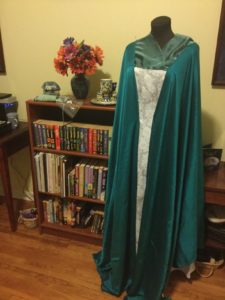Yesterday I built Irene’s chemise. It was…interesting.
Thanks to not marking the indicated stitching lines, I messed up the first two steps – stitching along the stitching lines at the center front neckline and then cutting a slash between them. My first seam cut the corner too quickly, so I had to pull it and redo. I gathered the top edge as instructed and got ready to attach the yoke. I peered carefully at the illustration to orient the yoke correctly, attached each side…and realized that the illustration started at center front. Off the yoke came, turned around, and on again it went. The parallel steps for the back blessedly went more smoothly, except that Tinkerbell kept trying to curl up on my lap.
Then came the sleeves. I got the sleeve oriented wrong side up, the shoulder line underneath it right side up…and sewed the sleeve to the neckline instead of the armhole side. Lather, rinse, repeat. Around this time I looked farther up the pattern instructions and finally noticed the header “Civil War Undergarments”. Yes, ladies and gents, Simplicity 2890 despite complete lack of indications on the outside, is intended for the 1860s. I decided to mentally reassure myself that I did indeed read a while ago that undergarments didn’t change much in the latter half of that century, and move on.
Next up, armhole facings. For once I got the orientation right on the first try, but I incorporated some shortcuts: stitching the non-seam edges down instead of pressing them. Once it was time to turn them under, I machine stitched them again, when they probably should have been hand finished. One of the four pieces also went in about an inch and a half lower than it was supposed to.
Then I put in flat-fell side seams, which was amusing since I’d read about flat-felled seams just last week. Rather than clipping the short edge, I actually set the seam slightly off to begin with – by accident on the first side, on purpose on the second. After that, it was time to face the yoke, at which point I realized I’d only cut one back yoke piece (as illustrated) instead of two. Since the instructions talked about starting with the shoulder seam, and the drawing indicated the same side facing up for front and back yoke, I decided to cut another. I used the selvage for the lower edge intended to be slipstitched to the garment (though of course I machine stitched again). I also sewed the hem, even though that wasn’t mentioned…

I did decide to use a snap instead of a button, since all of my buttons are quite modern and I’m still terrified of the buttonholer. And that was the final touch on my rather tent-like (aside from the tightly fitted sleeves) late 1800s chemise.







 the project, plus white thread, interfacing, 2 mother of pearl buttons, and lace from the stash. This piece was a joy to build. The fabric moved so consistently through the machine that I felt like I’d suddenly gotten massively better at sewing. I hand sewed the cuffs and hem just like I was supposed to, and it is clearly the most proficiently-built piece from the entire weekend.
the project, plus white thread, interfacing, 2 mother of pearl buttons, and lace from the stash. This piece was a joy to build. The fabric moved so consistently through the machine that I felt like I’d suddenly gotten massively better at sewing. I hand sewed the cuffs and hem just like I was supposed to, and it is clearly the most proficiently-built piece from the entire weekend. in green!). Oh! And I discovered that the best way to thread lacing through the hem at the knee is to take a USB to mini-USB cable and inch it through, then tie the lacing on and pull the cable back. At least they fit, and the yoke is more or less hidden by the doublet, not to mention accessory #1:
in green!). Oh! And I discovered that the best way to thread lacing through the hem at the knee is to take a USB to mini-USB cable and inch it through, then tie the lacing on and pull the cable back. At least they fit, and the yoke is more or less hidden by the doublet, not to mention accessory #1: